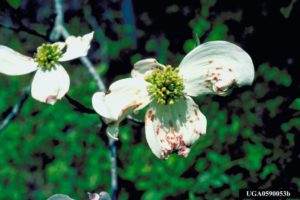America’s imports of plants to serve various purposes have been a major pathway for introduction of invasive species – both some of the plant species imported intentionally and insects and pathogens associated with those plant imports.
Examples of the former include numerous forage grasses, Callery pear (just past its peak bloom here in the MidAtlantic region), autumn and Russian olive, kudzu, shrub and vining euonymus, iceplant, … [see my blogs from January 2016 and March 2016 for more about invasive plants].
Pests introduced on imported plants range from chestnut blight and white pine blister rust at the beginning of the 20th Century to sudden oak death in the 1980s and probably the polyphagous and Kuroshio shot hole borers more recently. All these pests are described briefly here.
For lengthy discussions of the “plants for planting” pathway of introduction for insects and pathogens, read my report Fading Forests III available here; or the Liebhold et al. article referenced at the end of this blog.
A new article by Barry Yeoman describes the effects on wildlife species of these introductions. “Going Native: Exotic garden plants can wreak unexpected havoc with indigenous species and ecosystems” can be read here .
dogwood anthracnose; Robert L. Anderson. courtesy of bugwood.org
Yeoman notes that birds and other wildlife that feed on the fruits of native dogwood can’t utilize the fruits of the introduced kousa dogwood. Furthermore, native dogwoods have been decimated by dogwood anthracnose – probably introduced on imports of kousa dogwood! Another pest example cited by Yeoman is the loss of eastern hemlock to hemlock woolly adelgid.
Yeoman goes on to report the impacts on wildlife species of such invasive plant species as Japanese knotweed, autumn olive, Chinese tallowtree, and Japanese barberry. The last is even linked to higher populations of the ticks that spread Lyme disease.
Yeoman writes that the United States has “a feeble system of regulating garden imports. Each new species is presumed harmless until proven otherwise—and by the time a verdict arrives, the harm is often beyond repair.” He criticizes our government’s reliance on a modified blacklist system – a short list of “noxious weeds” . This approach allows potential invaders to enter the country without scientific evaluation.
As Yeoman describes in the article, the noxious weed list is supplemented by a small “graylist” of plant species that could potentially cause harm and are temporarily barred until they can be evaluated. Yeoman does not describe the program under which this “graylist” has been created. In May 2011, USDA APHIS created a temporary holding category, called “Not Authorized (for importation) Pending Pest Risk Analysis,” or NAPPRA. With this authority, APHIS may temporarily prohibit import of certain types of plants, from specific countries of origin, that it considers to pose a particular risk. The risk might be invasiveness of the plant species itself, or pests associated with the plants. The temporary prohibition on imports of those species gives APHIS time to complete a pest risk analysis and then enact appropriate safeguards to ensure that the imported plants will not be invasive or present as low a pest risk as possible.
For a more complete description of the graylist process, called NAPPRA, read Fading Forests III here .
The NAPPRA process holds the promise of providing substantial protection by curtailing imports of high-risk plants. However, its implementation has stalled. APHIS last proposed additions to the list of plant species prohibited entry temporarily in May 2013 – almost four years ago! APHIS should revive the NAPPRA process and utilize prompt listing of plants under this authority to minimize the risk that new pests will be introduced.
Sources
Liebhold, A.M., E.G. Brockerhoff, L.J. Garrett, J.L. Parke, and K.O. Britton. 2012. Live Plant Imports: the Major Pathway for Forest Insect and Pathogen Invasions of the US. www.frontiersinecology.org
We welcome comments that supplement or correct factual information, suggest new approaches, or promote thoughtful consideration. We post comments that disagree with us — but not those we judge to be not civil or inflammatory.
Posted by Faith Campbell
